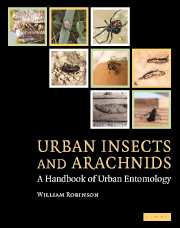Book contents
- Frontmatter
- Contents
- Preface
- Part I Urban entomology
- Part II Insects in the urban environment
- 4 Blattaria
- 5 Coleoptera
- 6 Collembola, Dermaptera
- 7 Diptera, Ephemeroptera
- 8 Hemiptera, Homoptera
- 9 Hymenoptera
- 10 Isoptera
- 11 Lepidoptera
- 12 Mantodea, Neuroptera
- 13 Orthoptera, Phasmatodea
- 14 Phthiraptera
- 15 Plecoptera, Psocoptera
- 16 Siphonaptera
- 17 Thysanoptera, Thysanura, Trichoptera
- Part III Other arthropods in the urban environment
- Family, genus, species index
- Index
- References
15 - Plecoptera, Psocoptera
Published online by Cambridge University Press: 06 August 2009
- Frontmatter
- Contents
- Preface
- Part I Urban entomology
- Part II Insects in the urban environment
- 4 Blattaria
- 5 Coleoptera
- 6 Collembola, Dermaptera
- 7 Diptera, Ephemeroptera
- 8 Hemiptera, Homoptera
- 9 Hymenoptera
- 10 Isoptera
- 11 Lepidoptera
- 12 Mantodea, Neuroptera
- 13 Orthoptera, Phasmatodea
- 14 Phthiraptera
- 15 Plecoptera, Psocoptera
- 16 Siphonaptera
- 17 Thysanoptera, Thysanura, Trichoptera
- Part III Other arthropods in the urban environment
- Family, genus, species index
- Index
- References
Summary
PLECOPTERA
Introduction
Adult stoneflies are soft-bodied, 2–5 cm long, with a brown and gray body. They usually have two pairs of wings; they fly readily, but not well. Antennae are long, and the cerci are well developed. Mouthparts are the chewing type, but they are weak. Nymphs resemble the adults, except for the lack of wings; they have external filamentous gills on the thorax and legs. Most species live in cool, running streams, or in cold mountain lakes. Plecopterans are an important component in aquatic food chains, especially for fish. Adult stoneflies are imitated in the design of fishing fly used by anglers. These insects are physiologically fragile and intolerant of water conditions of low oxygen or pollution, and they are useful indicators of these and other stream conditions. Pest status of stoneflies is linked to their appearance in large numbers in areas adjacent to breeding sites, and sometimes a long distance from water. These incidents are usually associated with one or two species. Adults of Perla and Pteronarcys are attracted to lights at night.
Mating in stoneflies involves males attracting females by rubbing, tapping, or drumming a species-specific signal on an available substrate. Females respond to the male's vibrational signals with acoustic signals of their own. Male stonefly mating calls vary from a series of single beats to complex patterns of beats and intervals. These sounds are produced by a hammer-like structure on the underside of the abdomen.
- Type
- Chapter
- Information
- Urban Insects and ArachnidsA Handbook of Urban Entomology, pp. 365 - 373Publisher: Cambridge University PressPrint publication year: 2005



